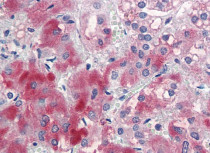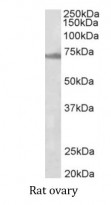ARG42135
anti-ENC1 antibody
anti-ENC1 antibody for IHC-Formalin-fixed paraffin-embedded sections,Western blot and Human,Rat
Overview
| Product Description | Goat Polyclonal antibody recognizes ENC1 |
|---|---|
| Tested Reactivity | Hu, Rat |
| Predict Reactivity | Ms, Cow, Dog, Pig |
| Tested Application | IHC-P, WB |
| Host | Goat |
| Clonality | Polyclonal |
| Isotype | IgG |
| Target Name | ENC1 |
| Antigen Species | Human |
| Immunogen | Synthetic peptide around the internal region of Human ENC1. (TSVSHDKLPKVQC) (NP_003624.1; NP_001243505.1) |
| Conjugation | Un-conjugated |
| Alternate Names | KLHL37; KLHL35; Kelch-like protein 37; TP53I10; PIG10; NRPB; Nuclear matrix protein NRP/B; CCL28; ENC-1; Ectoderm-neural cortex protein 1; p53-induced gene 10 protein |
Application Instructions
| Application Suggestion |
|
||||||
|---|---|---|---|---|---|---|---|
| Application Note | WB: Recommend incubate at RT for 1h. IHC-P: Antigen Retrieval: Steam tissue section in Citrate buffer (pH 6.0). * The dilutions indicate recommended starting dilutions and the optimal dilutions or concentrations should be determined by the scientist. |
||||||
| Positive Control | Rat ovary | ||||||
| Observed Size | ~ 70 kDa |
Properties
| Form | Liquid |
|---|---|
| Purification | Affinity purified |
| Buffer | Tris saline (pH 7.3), 0.02% Sodium azide and 0.5% BSA. |
| Preservative | 0.02% Sodium azide |
| Stabilizer | 0.5% BSA |
| Concentration | 0.5 mg/ml |
| Storage Instruction | For continuous use, store undiluted antibody at 2-8°C for up to a week. For long-term storage, aliquot and store at -20°C or below. Storage in frost free freezers is not recommended. Avoid repeated freeze/thaw cycles. Suggest spin the vial prior to opening. The antibody solution should be gently mixed before use. |
| Note | For laboratory research only, not for drug, diagnostic or other use. |
Bioinformation
| Database Links | |
|---|---|
| Gene Symbol | ENC1 |
| Gene Full Name | ectodermal-neural cortex 1 (with BTB domain) |
| Background | This gene encodes a member of the kelch-related family of actin-binding proteins. The encoded protein plays a role in the oxidative stress response as a regulator of the transcription factor Nrf2, and expression of this gene may play a role in malignant transformation. Alternatively spliced transcript variants encoding multiple isoforms have been observed for this gene. [provided by RefSeq, Feb 2012] |
| Function | Actin-binding protein involved in the regulation of neuronal process formation and in differentiation of neural crest cells. Down-regulates transcription factor NF2L2/NRF2 by decreasing the rate of protein synthesis and not via a ubiquitin-mediated proteasomal degradation mechanism. [UniProt] |
| Cellular Localization | Nucleus matrix. Cytoplasm. Cytoplasm, cytoskeleton. [UniProt] |
| Calculated MW | 66 kDa |
| PTM | Ubiquitinated by E3 ubiquitin ligase complex formed by CUL3 and RBX1 and probably targeted for proteasome-independent degradation. Quinone-induced oxidative stress increases its ubiquitination. [UniProt] |
Images (2) Click the Picture to Zoom In
-
ARG42135 anti-ENC1 antibody IHC-P image
Immunohistochemistry: Paraffin-embedded Human adrenal gland tissue. Antigen Retrieval: Steam tissue section in Citrate buffer (pH 6.0). The tissue section was stained with ARG42135 anti-ENC1 antibody at 5 µg/ml dilution followed by AP-staining.
-
ARG42135 anti-ENC1 antibody WB image
Western blot: 35 µg of Rat ovary lysate (in RIPA buffer) stained with ARG42135 anti-ENC1 antibody at 1 µg/ml dilution and incubated at RT for 1 hour.







